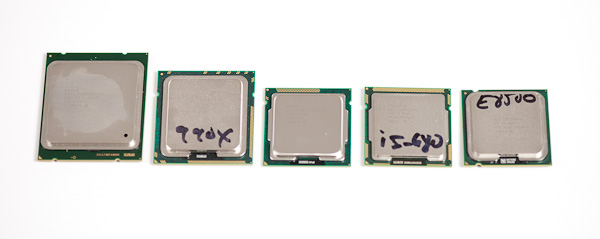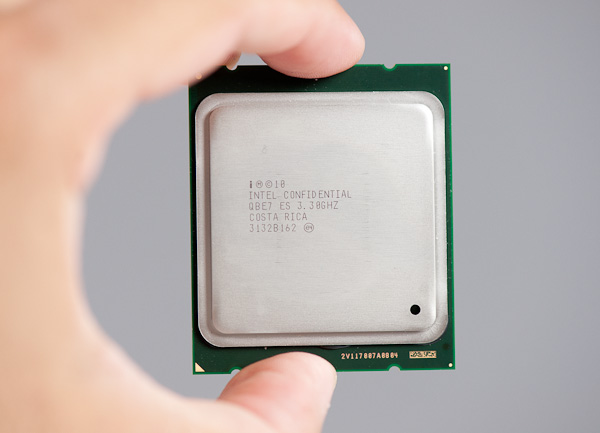Intel Core i7 3960X (Sandy Bridge E) Review: Keeping the High End Alive
by Anand Lal Shimpi on November 14, 2011 3:01 AM EST- Posted in
- CPUs
- Intel
- Core i7
- Sandy Bridge
- Sandy Bridge E
Final Words
There are two aspects of today's launch that bother me: the lack of Quick Sync and the chipset. The former is easy to understand. Sandy Bridge E is supposed to be a no-compromise, ultra high-end desktop solution. The lack of an on-die GPU with Quick Sync support means you have to inherently compromise in adopting the platform. I'm not sure what sort of a solution Intel could've come to (I wouldn't want to give up a pair of cores for a GPU+QuickSync) but I don't like performance/functionality tradeoffs with this class of product. Secondly, while I'm not a SAS user, I would've at least appreciated some more 6Gbps SATA ports on the chipset. Native USB 3.0 support would've been nice as well. Instead what we got was effectively a 6-series chipset with a new name. As Intel's flagship chipset, the X79 falls short.

From left to right: Intel Core i7 (SNB-E), Core i7 (Gulftown), Core i5 (SNB), Core i5 (Clarkdale), Core 2 Duo
LGA-2011, 1366, 1155, 1156, 775
The vast majority of desktop users, even enthusiast-class users, will likely have no need for Sandy Bridge E. The Core i7 3960X may be the world's fastest desktop CPU, but it really requires a heavily threaded workload to prove it. What the 3960X doesn't do is make your gaming experience any better or speed up the majority of desktop applications. The 3960X won't be any slower than the fastest Sandy Bridge CPUs, but it won't be tremendously faster either. The desktop market is clearly well served by Intel's LGA-1155 platform (and its lineage); LGA-2011 is simply a platform for users who need a true powerhouse.
There are no surprises there, we came to the same conclusion when we reviewed Intel's first 6-core CPU last year. If you do happen to have a heavily threaded workload that needs the absolute best performance, the Core i7 3960X can deliver. In our most thread heavy tests the 3960X had no problems outpacing the Core i7 2600K by over 50%. If your livelihood depends on it, the 3960X is worth its entry fee. I suspect for those same workloads, the 3930K will be a good balance of price/performance despite having a smaller L3 cache. I'm not terribly interested in next year's Core i7 3820. Its point is obviously for those users who need the memory bandwidth or PCIe lanes of SNB-E, but don't need more than four cores. I would've liked to have seen a value 6-core offering instead, but I guess with a 435mm2 die size it's a tough sell for Intel management.
Of course compute isn't the only advantage of the Sandy Bridge E platform. With eight DIMM slots on most high end LGA-2011 motherboards you'll be able to throw tons of memory at your system if you need it without having to shop for workstation motherboards with fewer frills.
As for the future of the platform, Intel has already begun talking about Ivy Bridge E. If it follows the pattern set for Ivy Bridge on LGA-1155, IVB-E should be a drop in replacement for LGA-2011 motherboards. The biggest issue there is timing. Ivy will arrive for the mainstream LGA-1155 platforms around the middle of 2012. At earliest, I don't know that we'd see it for LGA-2011 until the end of next year, or perhaps even early 2013 given the late launch of SNB-E. This seems to be the long-term downside to these ultra high-end desktop platforms these days: you end up on a delayed release cadence for each tick/tock on the roadmap. If you've always got to have the latest and greatest, this may prove to be frustrating. Based on what we know of Ivy Bridge however, I suspect that if you're using all six of these cores in SNB-E that you'll wish you had IVB-E sooner, but won't be tempted away from the platform by a quad-core Ivy Bridge on LGA-1155.
I do worry about the long term viability of the ultra high-end desktop platform. As we showed here, some of the gains in threaded apps exceed 50% over a standard Sandy Bridge. That's tangible performance to those who can use it. With the growth in cloud computing it's clear there's demand for these types of chips in servers. I just hope Intel continues to offer a version for desktop users as well.











163 Comments
View All Comments
ggathagan - Monday, November 14, 2011 - link
You assume correctly.As stated in the article, the 3820 is due out early next year and expected to run at about $300.
If you look at the 1st page of the article, you'll note that the 3820 is a little faster than the 2700K, with the same max in turbo mode and a larger L3 cache.
DanNeely - Monday, November 14, 2011 - link
Except that the 2700k is unlocked and the 3820 has a severe overclocking limit.theangryintern - Monday, November 14, 2011 - link
Thanks for the great review, Anand. I had been waiting for SNB-E to do an upgrade from my X58 Core i7, but now I'm thinking of saving some money and going with a regular Sandy Bridge, the gaming gains just aren't enough to justify the added expense.Makaveli - Monday, November 14, 2011 - link
That makes no sense there are no gaming games going from X58 to SB!You will still be GPU bottlenecked on most games!
And a whole new build will be an added expense for no gain in Games!
Beenthere - Monday, November 14, 2011 - link
Not much to see here except over-priced CPUs and mobos. Nice to see Intel fans smartening up and passing on these cash cows.Lazlo Panaflex - Monday, November 14, 2011 - link
Hi Anand, thanks for the review :)Apologize in advance if this was asked earlier, but what specifically is your criteria for determining a stable overclock? For example, do you run Prime95, large FFT's for a predetermined period of time, or perhaps IBT (Intel Burn Test) for a certain amount of runs? Or do you utilize some other tool? Just curious, since this question often pops up in the CPU forums, and everyone has their own opinion of what constitutes a stable overclock.
Regards,
LP
yankeeDDL - Monday, November 14, 2011 - link
LOL. Supply and the mand is the cause. Jacking up the price is the effect. You are a bit mixed up it seems.Also, in the consumer market having the fastest CPU (or GPU) that you sell for a ridiculous price doesn't mean that someone buys it.
How many people buy a HD6990? Few, and that's why supplies are so scarce.
The 3960X is a "show off" chip that claims performance crown. Anyone in the right state of mind will not buy it: it is just not worth the money it costs, unless you're in absolute need of few extra % of performance.
JlHADJOE - Tuesday, November 15, 2011 - link
We have chips priced at $1000 because the market has shown that it is willing to pay that amount to get the top-performing chip. It doesn't matter that AMD doesn't have an entry in that segment, because if it did, then we'd probably have AMD's FX-9300 or something priced at $900, while Intel sells their 3960X at $1100.This was the exact case when AMD was competitive, and their FX-57 was sold at $1100, vs Intel's Pentium EE which was going for $999. Was there a competitive AMD at the time? Yes. They were even in the lead. Were prices still jacked up? Yes.
The $1000 CPU will only go away if we, as consumers wise up and say we are not willing to pay that much money for a chip.
karkas - Monday, November 14, 2011 - link
Rapid STORY Technology?GTVic - Monday, November 14, 2011 - link
Lack of Quick Sync is not nearly the negative that the reviewer seems to think it is. It is not a well supported technology and not many people would use it on a day to day basis. This shouldn't even be mentioned in the article unless you also want to bring up support for Intel Viiv http://en.wikipedia.org/wiki/Intel_Viiv.